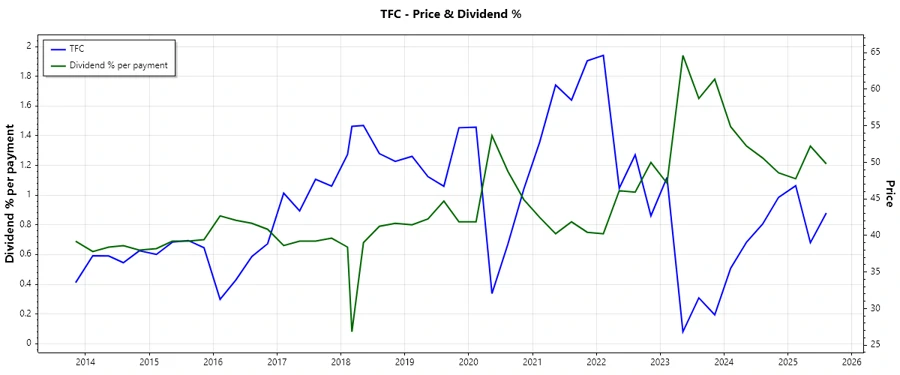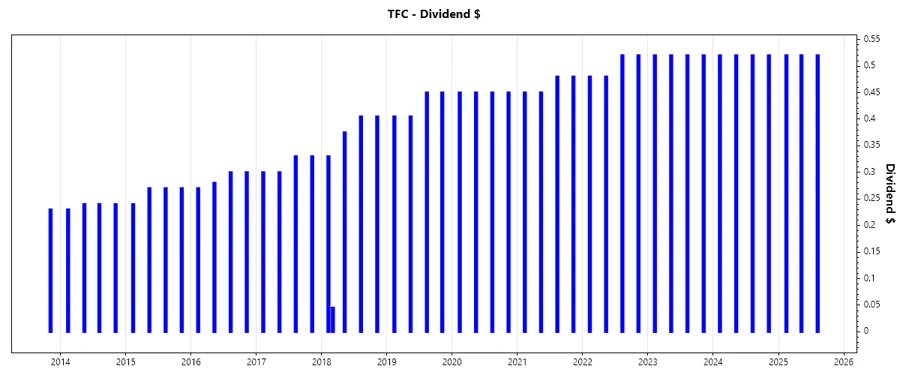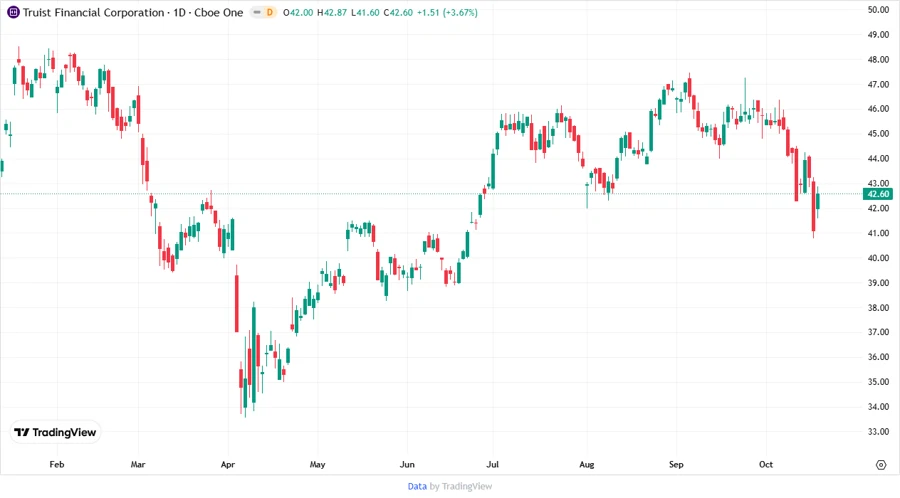October 18, 2025 a 07:46 am




TFC: Dividend Analysis - Truist Financial Corporation

Truist Financial Corporation demonstrates a stable dividend history with over four decades of consistent dividend payments, reflecting its commitment to shareholder value. With a generous dividend yield of 4.83% and a slight upward growth trajectory over the past years, TFC remains a formidable choice for income-focused investors. However, its high payout ratios may warrant closer attention, especially given market volatility and economic uncertainties.
📊 Overview
| Key Metric | Details |
|---|---|
| Sector | Financials |
| Dividend Yield | 4.83% |
| Current Dividend Per Share | 2.36 USD |
| Dividend History | 41 years |
| Last Cut or Suspension | None |
📉 Dividend History
Analyzing the dividend history gives insight into the company's commitment to returning capital to shareholders. A 41-year track record without cuts signifies strong financial health and prioritization of dividend payments by Truist Financial.

| Year | Dividend Per Share (USD) |
|---|---|
| 2025 | 1.56 |
| 2024 | 2.08 |
| 2023 | 2.08 |
| 2022 | 2.00 |
| 2021 | 1.86 |
📈 Dividend Growth
Dividend growth rates provide insights into future earnings potential and management's outlook. Truist Financial shows dividend growth of 3.80% over the last 3 years and 4.00% over 5 years, indicating moderate but steady progression.
| Time | Growth |
|---|---|
| 3 years | 3.80% |
| 5 years | 4.00% |
The average dividend growth is 4.00% over 5 years. This shows moderate but steady dividend growth.

🗣️ Payout Ratio
Payout ratios assess how comfortably a company can pay dividends out of its earnings. Truist Financial's EPS-based payout ratio stands at 60.67%, while its free cash flow payout is higher at 76.52%, suggesting a substantial portion of profit is paid as dividends, which might limit reinvestment in growth.
| Key Figure | Ratio |
|---|---|
| EPS-based | 60.67% |
| Free Cash Flow-based | 76.52% |
The EPS payout ratio of 60.67% allows room for reinvestment, but the higher FCF payout ratio may constrain future growth opportunities.
💡 Cashflow & Capital Efficiency
The cash flow and capital efficiency are crucial in sustaining dividends and achieving growth. With a strong free cash flow yield of 7.23% and a robust return on invested capital, Truist showcases effective capital use and an ability to cover its dividends and growth internally.
| Metric | 2023 | 2024 |
|---|---|---|
| Free Cash Flow Yield | 17.55% | 3.75% |
| Earnings Yield | -2.22% | 8.34% |
| CAPEX to Operating Cash Flow | N/A | N/A |
| Stock-based Compensation to Revenue | N/A | N/A |
| Free Cash Flow / Operating Cash Flow Ratio | 1 | 1 |
The cash flow metrics signify the company's ability to maintain its dividend payout and signify investment potential through efficient capital management.
📉 Balance Sheet & Leverage Analysis
The financial stability of Truist Financial is reflected through its balanced debt ratios and leverage metrics. This stability supports reliable dividend payments amidst debt conditions.
| Metric | 2023 | 2024 |
|---|---|---|
| Debt-to-Equity | 1.05 | 0.98 |
| Debt-to-Assets | 0.12 | 0.12 |
| Debt-to-Capital | 0.51 | 0.49 |
| Net Debt to EBITDA | 70.87 | 59.52 |
| Current Ratio | N/A | 0.14 |
| Quick Ratio | 0.26 | 0.14 |
| Financial Leverage | 9.06 | 8.34 |
The leverage analysis underscores Truist's balanced capital structure, supporting its financial obligations and dividend policy while potentially enhancing growth opportunities.
🚀 Fundamental Strength & Profitability
The fundamental strength and profitability of Truist Financial showcase its resilience in terms of ROE, ROA, and profit margins, which are pivotal for sustainable dividends and reinvestment strategies.
| Metric | 2023 | 2024 |
|---|---|---|
| Return on Equity | -1.85% | 7.57% |
| Return on Assets | -0.20% | 0.91% |
| Net Margin | -3.64% | 19.87% |
| EBIT Margin | -2.55% | -2.48% |
| EBITDA Margin | 1.50% | 1.56% |
| Gross Margin | 59.81% | 47.04% |
| R&D to Revenue | N/A | N/A |
The displayed profitability metrics demonstrate Truist's robust operational performance, which positively impacts its dividend continuity and financial stability.
📈 Price Development

🗳️ Dividend Scoring System
| Category | Score | Rating |
|---|---|---|
| Dividend Yield | 5 | |
| Dividend Stability | 5 | |
| Dividend Growth | 3 | |
| Payout Ratio | 3 | |
| Financial Stability | 4 | |
| Dividend Continuity | 5 | |
| Cashflow Coverage | 4 | |
| Balance Sheet Quality | 4 |
Overall Score: 33/40
✅ Rating
Truist Financial Corporation is rated as a reliable dividend-paying stock, particularly suited for long-term income and value-oriented investors. Its stable and consistent dividend policies, backed by steady cash flow and a sound capital structure, underline its investment appeal amidst economic cycles. Potential investors should consider the moderate growth of dividends and the high payout ratios in their valuation analysis.
